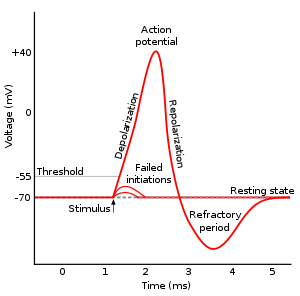
Afterhyperpolarization
Encyclopedia

Hyperpolarization (biology)
Hyperpolarization is a change in a cell's membrane potential that makes it more negative. It is the opposite of a depolarization.Hyperpolarization is often caused by efflux of K+ through K+ channels, or influx of Cl– through Cl– channels. On the other hand, influx of cations, e.g...
phase of a neuron's action potential
Action potential
In physiology, an action potential is a short-lasting event in which the electrical membrane potential of a cell rapidly rises and falls, following a consistent trajectory. Action potentials occur in several types of animal cells, called excitable cells, which include neurons, muscle cells, and...
where the cell's membrane potential
Membrane potential
Membrane potential is the difference in electrical potential between the interior and exterior of a biological cell. All animal cells are surrounded by a plasma membrane composed of a lipid bilayer with a variety of types of proteins embedded in it...
falls below the normal resting potential
Resting potential
The relatively static membrane potential of quiescent cells is called the resting membrane potential , as opposed to the specific dynamic electrochemical phenomena called action potential and graded membrane potential....
. This is also commonly referred to as an action potential's undershoot phase. Afterhyperpolarization in part causes the refractory period, the time period following an action potential during which a neuron cannot initiate a subsequent action potential.
During the action potential, the raised voltage opens many more potassium channels than usual, and some of these do not close right away when the membrane returns to its normal resting voltage. In addition, further potassium channels
SK channel
SK channels are a subfamily of Ca2+-activated K+ channels. They are so called because of their small single channel conductance, ~10 pS. SK channels are a type of ion channel allowing potassium cations to cross the cell membrane and are activated by an increase in the concentration of...
open in response to the influx of calcium ions during the action potential. The potassium permeability of the membrane is transiently unusually high, driving the membrane voltage Vm even closer to the potassium equilibrium voltage EK. Hence, there is an undershoot or hyperpolarization
Hyperpolarization (biology)
Hyperpolarization is a change in a cell's membrane potential that makes it more negative. It is the opposite of a depolarization.Hyperpolarization is often caused by efflux of K+ through K+ channels, or influx of Cl– through Cl– channels. On the other hand, influx of cations, e.g...
that persists until the membrane potassium permeability returns to its usual value.
Both medium and slow afterhyperpolarization currents can be demonstrated in neurons. The SK channel
SK channel
SK channels are a subfamily of Ca2+-activated K+ channels. They are so called because of their small single channel conductance, ~10 pS. SK channels are a type of ion channel allowing potassium cations to cross the cell membrane and are activated by an increase in the concentration of...
, a calcium-activated potassium channel, is the major mediator of afterhyperpolarization currents, although other candidate mediators have been suggested.

